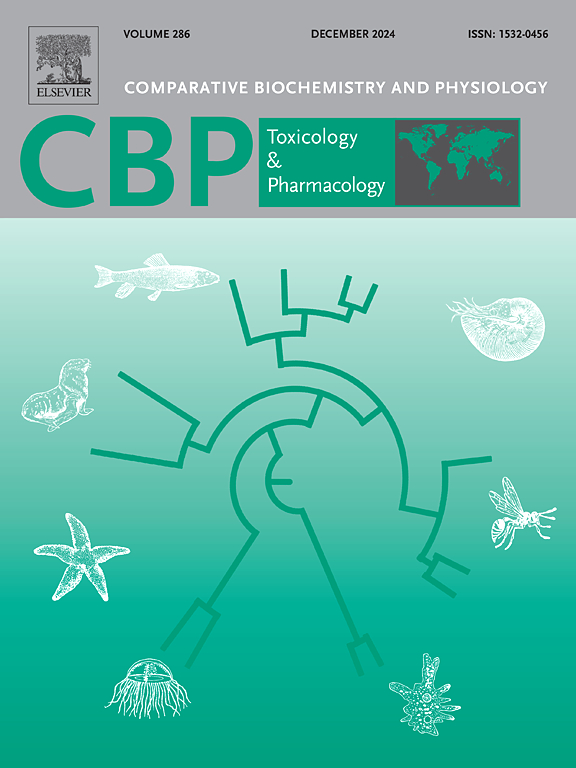Structure, transduction pathway, behavior and toxicity of fish olfactory in aquatic environments
IF 3.9
3区 环境科学与生态学
Q2 BIOCHEMISTRY & MOLECULAR BIOLOGY
Comparative Biochemistry and Physiology C-toxicology & Pharmacology
Pub Date : 2025-03-17
DOI:10.1016/j.cbpc.2025.110195
引用次数: 0
Abstract
The olfactory system in teleost fish plays a vital role as chemosensory organ that directly interacts with the aquatic environment, exhibiting high sensitivity to chemical alteration in aquatic environments. However, despite its importance, there has been a lack of systematic reviews in the past decade on fish olfactory structure, transduction mechanisms, and the impact of environmental pollutants on olfactory toxicity. This study analyzed 272 relevant studies, focusing on the role of the olfactory system and the disruption of olfactory function by contaminants. Fish processes odors through olfactory receptor neurons, olfactory nerves, mitral/ruffed cells, glomeruli, and neurotransmitters, mediated by membrane potentials resulting from ion channels in the olfactory epithelium and olfactory bulb, which are then relayed to higher brain regions via the medial olfactory tracts and lateral olfactory tracts for further integration and modulation. This process minimizes the overlap between complex odor sets, ensuring distinct representation of each odor and eliciting appropriate olfactory-mediated behaviors, such as feeding, migration, alarm responses, and reproduction. Current research identifies four main types of contaminants affecting the fish olfactory system: heavy metals (51.60 %), organic contaminants (33.79 %), acidification (12.33 %), and salinity (5.94 %). The main mechanisms of impact are: morphological changes (21.19 %), alterations in olfactory receptors (29.24 %), damage to olfactory receptor neurons and neurotransmitters disruption (26.69 %), plasticity (2.97 %), and defense mechanisms (19.92 %). We also identify uncertainties and proposes future research directions on the effects of contaminants on fish olfactory. Overall, this review provides valuable insights into the toxicity of contaminants on fish olfactory.

水生环境中鱼类嗅觉的结构、转导途径、行为和毒性
硬骨鱼的嗅觉系统是直接与水生环境相互作用的化学感觉器官,对水生环境中的化学变化具有高度敏感性。然而,尽管它很重要,但在过去的十年中,对鱼类嗅觉结构、传导机制以及环境污染物对嗅觉毒性的影响缺乏系统的综述。本研究分析了272项相关研究,重点关注嗅觉系统的作用以及污染物对嗅觉功能的破坏。鱼类通过嗅觉受体神经元、嗅觉神经、二尖瓣/皱状细胞、肾小球和神经递质处理气味,由嗅上皮和嗅球中的离子通道产生的膜电位介导,然后通过内侧嗅束和外侧嗅束传递到更高的大脑区域,进一步整合和调节。这一过程最大限度地减少了复杂气味集之间的重叠,确保了每种气味的独特表现,并引发了适当的嗅觉介导行为,如进食、迁徙、报警反应和繁殖。目前的研究确定了影响鱼类嗅觉系统的四种主要污染物:重金属(51.60%)、有机污染物(33.79%)、酸化(12.33%)和盐度(5.94%)。其主要影响机制为:形态改变(21.19%)、嗅觉受体改变(29.24%)、嗅觉神经元损伤和神经递质破坏(26.69%)、可塑性(2.97%)和防御机制(19.92%)。我们还指出了不确定因素,并提出了污染物对鱼类嗅觉影响的未来研究方向。综上所述,本文对污染物对鱼类嗅觉的毒性研究提供了有价值的见解。
本文章由计算机程序翻译,如有差异,请以英文原文为准。
求助全文
约1分钟内获得全文
求助全文
来源期刊
CiteScore
7.50
自引率
5.10%
发文量
206
审稿时长
30 days
期刊介绍:
Part C: Toxicology and Pharmacology. This journal is concerned with chemical and drug action at different levels of organization, biotransformation of xenobiotics, mechanisms of toxicity, including reactive oxygen species and carcinogenesis, endocrine disruptors, natural products chemistry, and signal transduction with a molecular approach to these fields.

 求助内容:
求助内容: 应助结果提醒方式:
应助结果提醒方式:


